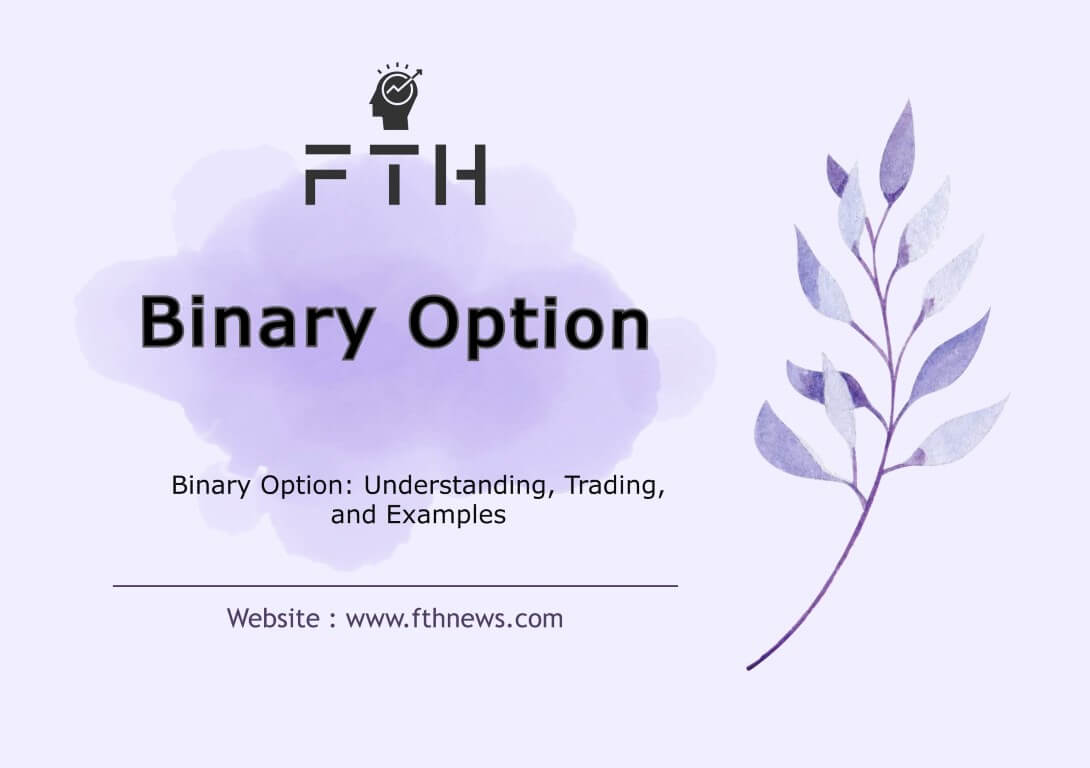
Binary Option: Understanding, Trading, and Examples
Binary option have emerged as a popular and exciting form of financial trading, offering traders a unique way to capitalize on market movements. In this comprehensive guide, we’ll delve into the concept of binary options, how they work, and the advantages they present to traders. Whether you’re a novice or an experienced trader, understanding the dynamics of binary options can be key to making informed decisions and maximizing your profits.
Binary Option Defined:
Binary option serve as financial derivatives that simplify the trading process by distilling it down to two potential outcomes upon expiration: a predetermined profit or a loss of the initial investment. The term “binary” encapsulates the essence of these options, emphasizing the dual nature of the potential results. Traders engage in binary options by speculating on the direction of an asset’s price movement within a predefined timeframe, making it a straightforward yet dynamic trading instrument.
In essence, binary options transform complex financial market movements into a clear-cut decision: whether the asset’s price will rise or fall within a specified period. This simplicity is a key attraction for traders, providing a structured and controlled environment where risk and reward are precisely defined. The binary nature of the outcomes, either achieving a fixed profit or facing a limited loss, contributes to the accessibility and appeal of binary options across a wide spectrum of traders, from novices to seasoned professionals.
Understanding Binary Option:
When delving into the world of binary option, traders are presented with a canvas of opportunities defined by three crucial elements. Each element plays a pivotal role in shaping the trajectory of a trade, offering traders a nuanced approach to financial markets. Let’s unravel the key elements that underpin the dynamics of binary options trading:
1. Underlying Market:
In the diverse realm of binary option, traders enjoy the freedom to select from an array of markets. Whether it’s the familiar terrain of Forex, stocks, and commodities or the unique landscape of event-based options, the choice of the underlying market is the compass for your binary option journey. This selection not only tailors your strategy but also aligns it with the intricacies of your chosen asset class. It’s the starting point where market analysis and strategic planning converge to pave the way for a successful trade.
2. Hit Price (Strike Price):
At the core of every binary option trade lies the “Hit Price” or “Strike Price.” This pivotal value serves as the linchpin for decision-making, as traders forecast whether the market will ascend beyond or descend below this designated level within a predetermined timeframe. Here, the art of understanding and analyzing potential market movements relative to the strike price emerges as a crucial skill. Armed with this insight, traders are empowered to make informed decisions, transforming the seemingly binary outcome into a canvas of strategic possibilities.
3. Expiration Date and Time:
Binary option thrive on the ticking clock, offering traders the unique ability to set a timeframe for their trades. This temporal dimension, ranging from minutes to a week, dictates the lifespan of your trade. The crux of profitability lies in the market’s positioning concerning the strike price precisely at the moment of expiration. Mastery of this temporal element grants traders the ability to navigate the trajectory of the underlying asset, making calculated predictions that add a strategic layer to the binary options trading experience.
In essence, comprehending these key elements is not just advantageous; it’s imperative for grasping the dynamics of binary options. Navigating and leveraging the underlying market, strike price, and expiration time empower traders to transcend the binary nature of these options. With informed choices, binary options cease to be mere financial instruments; they transform into a strategic avenue for trading success, where each element contributes to the creation of a unique and personalized trading narrative.
How Binary Options Work:
Understanding the mechanics of binary option is essential for any trader seeking to navigate this dynamic financial landscape. Let’s unravel the intricacies of how binary options operate:
Automatic Exercise:
Binary options follow a straightforward ‘yes or no’ proposition. Upon reaching the expiration time, the option is automatically exercised. Traders need not manually execute the trade, simplifying the process and reducing the potential for human error. This automation ensures that outcomes are swift and precisely aligned with the agreed-upon conditions.
Payouts and Losses:
The crux of binary options lies in the clarity of outcomes. When an option expires in the money—meaning the predicted market direction is correct—traders receive predetermined payouts. Conversely, if the option expires out of the money, losses are incurred, amounting to the initial investment. This binary nature allows traders to precisely gauge their potential gains or losses, fostering transparency and informed decision-making.
Price Range (0 to 100):
Binary options introduce a unique pricing structure that ranges from 0 to 100. This range represents the likelihood or probability of an event occurring. A binary option priced at 0 indicates a perceived zero chance of the predicted event happening, while an option priced at 100 suggests absolute certainty. This pricing mechanism provides traders with clear risk management tools, allowing them to assess and control their exposure in the market. It also reflects the market’s consensus on the probability of the event occurring.
In essence, the automated execution, predetermined payouts, and the clear price range of binary options contribute to a trading environment characterized by simplicity and transparency. Traders can engage with confidence, knowing that the outcomes are predefined, risks are well-defined, and the pricing structure provides valuable insights into market sentiments. This clarity distinguishes binary options as a concise and accessible financial instrument, appealing to traders seeking a precise and efficient trading experience.
Advantages of Binary Option Contracts:
Engaging in binary option trading offers a host of advantages that cater to traders of all levels. Let’s delve into these benefits, making binary options an enticing prospect in the world of financial trading:
Profit Regardless of Market Direction:
One of the standout features of binary option is the ability to profit regardless of market direction. Whether anticipating a market rise or fall, binary options empower traders to capitalize on their forecasts. This flexibility allows traders to navigate various market conditions, turning both bullish and bearish trends into opportunities for financial gain.
Fixed Risk:
Knowledge is power in the world of trading, and binary options provide traders with a clear advantage by offering fixed risk. Before executing a trade, traders know the potential outcomes, eliminating the uncertainty associated with traditional trading instruments. This fixed risk feature enables effective risk management, allowing traders to make informed decisions about their exposure and potential losses.
Simple Yes/No Questions:
Binary options simplify the decision-making process with straightforward yes/no questions. This characteristic makes binary options accessible to both novice and experienced traders alike. Whether you’re just entering the trading arena or are a seasoned professional, the simplicity of binary options streamlines the decision-making process, reducing complexity and facilitating quicker, more decisive actions.
Option to Close the Trade Early:
Flexibility is a hallmark of binary options, and the option to close a trade before its expiration adds a layer of strategic control. Traders can take proactive steps to preserve profits or limit losses by closing positions early. This feature allows for dynamic decision-making based on real-time market conditions, empowering traders to adapt to changing circumstances and optimize their trading outcomes.
In essence, the advantages of binary options contracts extend beyond their simplicity. They offer a versatile and accessible platform for traders to navigate the financial markets, providing clear risk management tools, flexibility, and the potential for profit in various market scenarios. Whether you’re a newcomer or an experienced trader, these advantages position binary options as an attractive and dynamic avenue for achieving your financial goals.
Disadvantages of Binary Options Contracts:
While binary options contracts offer certain advantages, it’s crucial to be aware of the potential disadvantages associated with this form of trading. Understanding these drawbacks is essential for making informed decisions and managing risks effectively. Here are some key disadvantages of binary options contracts:
Limited Market Access:
Binary options typically cover a limited range of underlying assets, and the availability of different markets may be restricted. This limitation can constrain traders who prefer a broader selection of assets for their trading strategies.
Fixed Expiry Times:
Binary options have fixed expiry times, which can be a disadvantage for traders who prefer more flexibility in their trading durations. The inability to adjust the expiry time once a trade is initiated may limit the precision of market timing strategies.
Risk of Overly Simplified Trading:
While the simplicity of binary options is an advantage for many traders, it can be a disadvantage for those seeking more intricate trading strategies. Binary options’ yes/no nature might oversimplify market analysis for experienced traders who are accustomed to more complex financial instruments.
Limited Hedging Opportunities:
Binary options may have limited hedging possibilities compared to other financial instruments. Traders who rely on sophisticated hedging strategies to mitigate risks in traditional markets may find binary options less accommodating in this regard.
Broker Dependency:
Success in binary options trading is often contingent on the reliability and integrity of the broker. Some traders may face challenges related to unregulated or unscrupulous brokers, making it essential to choose a reputable and well-regulated broker.
Potential for Unpredictable Market Movements:
Binary options trading is highly dependent on short-term market movements, which can be unpredictable and subject to sudden changes. Rapid price fluctuations can lead to unexpected outcomes, even for well-informed traders, making risk management a critical aspect of binary options trading.
Negative Perception and Regulation:
Binary options have faced scrutiny and negative perceptions due to the potential for fraudulent activities and the high-risk nature of this form of trading. Regulatory authorities in some jurisdictions have imposed restrictions or outright bans on binary options trading, limiting its accessibility for traders.
It’s important for traders to carefully consider these disadvantages and weigh them against the potential benefits. Like any form of trading, success in binary options requires thorough research, disciplined risk management, and a clear understanding of the market dynamics. Traders should be aware of both the advantages and disadvantages to make informed decisions and enhance their overall trading experience.
How to Trade Binary Options:
Navigating the world of binary options requires a strategic approach and a clear understanding of the market dynamics. Here’s a step-by-step guide on how to trade binary options effectively:
Know the Market Trends:
Stay ahead of the game by staying well-informed about market movements and trends. Regularly analyze financial news, economic indicators, and other relevant information that could impact your chosen asset class. Identifying trends early on allows you to make more informed predictions about market directions, a crucial aspect of successful binary options trading.
Select the Market:
Choose the asset class that aligns with your trading strategy and preferences. Whether it’s currencies in the Forex market, stocks, commodities, or event-based options, selecting the right market sets the stage for a well-informed trade. Consider factors such as market volatility, liquidity, and historical price movements to make a judicious choice.
Select Strike Price and Expiration:
Make informed decisions about the strike price and expiration timeframe. The strike price is the central pivot, and your analysis should gauge whether the asset’s price will surpass or fall below this level. Simultaneously, carefully choose the expiration timeframe, as it defines the duration of your trade. A well-thought-out strike price and expiration timeframe enhance the precision of your market predictions.
Execute Your Deal:
Armed with market analysis and a carefully chosen asset class, it’s time to execute your trade. Place your order with your chosen binary options broker based on your predictions. The execution phase demands clarity, so ensure you enter the trade with a clear understanding of the potential risks and rewards.
Wait for Expiration or Close Early:
After executing your trade, closely monitor its progress until the expiration time. Binary options provide the option to close a trade early, offering a dynamic way to manage outcomes. If market conditions shift or your objectives change, consider closing the trade before expiration to either secure profits or limit potential losses. This strategic flexibility is a valuable tool for binary options traders.
By following these steps, traders can approach binary options trading with a structured and informed strategy. It’s important to continually refine your skills, adapt to market changes, and stay disciplined in your approach. Successful binary options trading involves a combination of market knowledge, strategic decision-making, and the ability to manage risks effectively.
Types of Binary Option Transactions:
When engaging in binary options trading, understanding the distinct types of transactions is vital for informed decision-making. Let’s delve into the specifics of two prominent options:
High-Low:
- Overview: High-Low binary options hinge on predicting whether the asset’s price will be above or below its current value when the contract expires.
- Execution: Successful predictions yield profits at expiration, while incorrect ones result in the loss of the invested amount.
- Strategy: Ideal for gauging general market direction, this option requires careful analysis of trends and potential price movements.
Call-Put:
- Overview: Call-Put binary options necessitate predicting whether the asset’s price will be higher or lower than a predetermined target at contract expiration.
- Execution: Accurate predictions lead to profits, while inaccurate ones incur losses.
- Strategy: This option involves a specific target price, demanding more precise analysis. Traders must determine if the price will surpass the specified level.
Understanding the intricacies of these binary option transactions empowers traders to customize their strategies based on market conditions and risk tolerance. The High-Low approach, with its simplicity, suits those assessing general trends, while the Call-Put option demands precision, enabling diverse trading strategies grounded in thorough market analysis.
Making Money from Binary Option:
When venturing into the world of binary options, a strategic approach is crucial for success. Follow these guidelines to increase your chances of profitable outcomes:
Training and Market Analysis:
Comprehensive Learning: Dive deep into market dynamics and trends through extensive training. Acquire a nuanced understanding of chart patterns and leverage technical and fundamental indicators for well-informed decision-making.
Strategic Analysis: Develop analytical skills to interpret market movements. Identify potential entry points and anticipate price trends. Informed analysis is the cornerstone of successful binary options trading.
Choosing the Best Broker:
Reliability and Reputation: Select a broker with a solid reputation. Consider factors like ratings, fees, and customer support. Evaluate broker facilities and market conditions to ensure a trustworthy partner in your trading journey.
Regulatory Compliance: Prioritize brokers regulated by reputable authorities to enhance the security and transparency of your trading experience.
Risk Management:
Prudent Risk Control: Implement careful risk management strategies to safeguard against potential losses. Limit the investment amount in each contract, preventing a single trade from disproportionately impacting your overall capital.
Consistent Evaluation: Regularly assess and adjust risk management approaches based on market conditions, trading performance, and individual risk tolerance.
Using Different Methods:
Diversify Strategies: Explore various binary option methods, including High-Low, Call-Put, or One Touch. Experiment with different analyses such as technical, fundamental, or sentiment analysis to diversify your trading strategies.
Adaptability: Be adaptable in your approach, adjusting methods based on evolving market conditions and the performance of different strategies.
Start with a Small Amount:
Gradual Entry: Initiate your trading journey with a small amount to minimize potential losses and gain practical experience. Starting small allows you to learn from mistakes without significant financial repercussions.
Experience Building: Gradually increase your investment size as you gain confidence and experience in the binary options market. This gradual approach helps build expertise while mitigating early risks.
By incorporating these practices into your binary options trading routine, you enhance your chances of making informed decisions, managing risks effectively, and ultimately achieving success in this dynamic financial market.
Examples of Binary Option
Binary options provide a diverse range of trading choices, each with distinct features and potential results. Here are examples of various binary options:
- High-Low Option:
- Prediction: Will the asset price be higher or lower than the current value at the contract expiration?
- Outcome: If the prediction is correct, the trader profits; if incorrect, the investment is lost.
- Call-Put Option:
- Prediction: Will the asset price be higher or lower than a predetermined target at contract expiration?
- Outcome: Correct predictions lead to profits; incorrect predictions result in losses.
- One Touch Option:
- Prediction: Will the asset price touch a specified level before the contract expires?
- Outcome: Profits if the price touches the level; losses if it doesn’t.
- Boundary Option:
- Prediction: Will the asset price stay within or go outside a predetermined range at expiration?
- Outcome: Profits if the price stays within the range; losses if it goes outside.
- 60-Second Option:
- Prediction: Will the asset price be higher or lower than the current value in the next 60 seconds?
- Outcome: Quick results with profits for correct predictions and losses for incorrect ones.
These examples represent different types of binary options, each with its unique characteristics and potential outcomes. Traders can choose the option that aligns with their market analysis and risk tolerance.
Binary Options vs. Forex Trading:
Distinguishing between binary options and forex trading is crucial for traders seeking the most suitable financial instrument for their investment goals. Here’s a comparative breakdown of these two trading forms:
Binary Options:
- Profit/Loss Predetermined in Advance:
- In binary options trading, traders know their potential profit or loss before entering a trade. This pre-determined nature of outcomes provides clarity and allows for more precise risk management.
- Fixed Expiration Time:
- Binary options have a fixed expiration time, which means traders commit to a specific timeframe for the trade. This fixed period adds a level of simplicity to the trading process but may limit flexibility for those seeking longer-term strategies.
- Limited Diversity in Trading:
- Binary options cover a limited range of underlying assets and markets. While they include popular choices like Forex, stocks, commodities, and events, the variety is more constrained compared to the expansive range available in forex trading.
- Trades Within Normal Market Hours:
- Binary options trades generally occur within standard market hours. This can be an advantage for traders who prefer the stability of regular market conditions, but it may limit opportunities for those seeking extended trading hours.
- No Potential for Leverage:
- Binary options trading typically does not offer leverage. Traders commit a fixed amount per trade, eliminating the potential for magnified gains or losses through leverage.
Forex Trading:
- No Profit/Loss Limit:
- In forex trading, there is no pre-determined limit on profit or loss. The potential for profit is theoretically unlimited, but it also means that losses can accumulate without a set boundary. Effective risk management is crucial in forex trading.
- No Fixed Expiration Time:
- Forex trading allows for more flexibility regarding trade duration. Positions can be held for as short or as long as the trader desires, providing adaptability to different market conditions and trading strategies.
- Greater Diversity in Trading:
- Forex trading boasts a vast array of currency pairs, offering traders unparalleled diversity. This extensive selection enables traders to align their strategies with a multitude of global economic factors.
- 24/5 Trading Hours:
- Forex markets operate 24 hours a day, five days a week, due to the global nature of currency trading. This constant availability allows for more extensive market access and the ability to react to global events in real-time.
- Potential for High Leverage:
- Forex trading often involves the use of leverage, enabling traders to control larger positions with a smaller amount of capital. While leverage can amplify profits, it also magnifies potential losses, making risk management crucial.
In conclusion, the choice between binary options and forex trading depends on individual preferences, risk tolerance, and trading objectives. Binary options offer simplicity and predefined outcomes, while forex trading provides greater diversity, flexibility, and the potential for higher leverage. Traders should carefully evaluate these factors to determine which market aligns best with their unique trading preferences and goals.
Conclusion:
Binary options provide an exciting and accessible opportunity for traders to engage in financial markets with defined risks and rewards. As you embark on your binary options journey, remember to stay disciplined, continually practice, and develop a clear trading plan to enhance your chances of success. Whether you’re a newcomer or an experienced trader, the simplicity and versatility of binary options make them a valuable addition to your trading toolkit.
FAQ
The legality of binary options varies by jurisdiction. It is legal in some countries and regulated, while in others, it may be restricted or considered illegal.
Yes, it is possible to make money with binary options, but success requires market knowledge, strategic planning, and risk management.
While binary options share similarities with gambling, success in trading can be influenced by market analysis and strategy. However, it still involves risk.
Binary options trading is legal in the USA but is highly regulated. Brokers must adhere to strict standards set by the Commodity Futures Trading Commission (CFTC).














